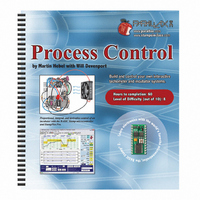122-28176 Parallax Inc, 122-28176 Datasheet - Page 240

122-28176
Manufacturer Part Number
122-28176
Description
GUIDE STUDENT PROCESS CONTROL
Manufacturer
Parallax Inc
Specifications of 122-28176
Accessory Type
Manual
Product
Microcontroller Accessories
Lead Free Status / RoHS Status
Contains lead / RoHS non-compliant
For Use With/related Products
Propeller Education (PE) Kit
Lead Free Status / RoHS Status
Lead free / RoHS Compliant, Contains lead / RoHS non-compliant
- Current page: 240 of 330
- Download datasheet (11Mb)
Additional Information
The op-amp can be employed here to control an on-off system without the expense of a
microcontroller, ADC, and all the additional hardware. While we won't ask you tear
down your circuit for this, you may wish to try it at a later time. Consider the schematic
in Figure 7-6.
Recall the output of the op-amp attempts to drive the inverting input (−) towards the non-
inverting input (+). In this configuration, if the temperature is lower than the setpoint
(1.015 V = 101.5 °F), the op-amp output will go high in an attempt to drive the inverting
input down to the non-inverting. But the output is NOT connected to the inverting input,
so the op-amp will drive fully to the positive supply-voltage rail in a futile attempt at
affecting the inverting terminal. This causes the transistor to go into saturation, turning
on the heater.
Once temperature rises above the setpoint, the op-amp will drive to the other rail voltage
(ground/Vss) in an attempt to lower the inverting input towards the non-inverting input.
This will have the effect of turning off the heater. Thus, the heater will cycle around the
setpoint.
This op-amp configuration is called a comparator because its output is based on a
comparison of the two inputs. A digital signal output is based on comparing two analog
voltages.
Figure 7-6
Op-Amp On-Off
Control Circuit
DO NOT BUILD
Related parts for 122-28176
Image
Part Number
Description
Manufacturer
Datasheet
Request
R

Part Number:
Description:
MANUAL FOR SUMOBOT
Manufacturer:
Parallax Inc
Datasheet:

Part Number:
Description:
GUIDE STUDENT SMART SENSORS
Manufacturer:
Parallax Inc
Datasheet:

Part Number:
Description:
MANUAL PROPELLER
Manufacturer:
Parallax Inc
Datasheet:

Part Number:
Description:
LEAD WIRES FLYING CABLE III/IV
Manufacturer:
Xilinx Inc
Datasheet:

Part Number:
Description:
BOARD ADAPTER AND FLY LEADS
Manufacturer:
Xilinx Inc
Datasheet:

Part Number:
Description:
PLATFORM CABLE USB II
Manufacturer:
Xilinx Inc
Datasheet:

Part Number:
Description:
KIT STARTER COOLRUNNER-II BUNDLE
Manufacturer:
Xilinx Inc
Datasheet:

Part Number:
Description:
Microcontroller Modules & Accessories DISCONTINUED BY PARALLAX
Manufacturer:
Parallax Inc

Part Number:
Description:
Microcontroller Modules & Accessories DISCONTINUED BY PARALLAX
Manufacturer:
Parallax Inc

Part Number:
Description:
BOOK UNDERSTANDING SIGNALS
Manufacturer:
Parallax Inc
Datasheet:

Part Number:
Description:
BOARD EXPERIMENT+LCD NX-1000
Manufacturer:
Parallax Inc
Datasheet:

Part Number:
Description:
IC MCU 2K FLASH 50MHZ SO-18
Manufacturer:
Parallax Inc
Datasheet:












